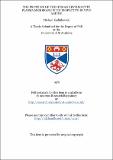Files in this item
The proteins of the human erythrocyte plasma membrane with respect to in vivo ageing
Item metadata
| dc.contributor.advisor | Lamb, J. F. | |
| dc.contributor.author | Kadlubowski, Michael | |
| dc.coverage.spatial | 191 p. | en_US |
| dc.date.accessioned | 2018-07-04T11:44:42Z | |
| dc.date.available | 2018-07-04T11:44:42Z | |
| dc.date.issued | 1976 | |
| dc.identifier.uri | https://hdl.handle.net/10023/14911 | |
| dc.description.abstract | Fresh human red blood cells were fractionated according to their in vivo age by simple centrifugation in order that changes in the membrane proteins could be investigated. Accepted criteria were used to assess the fractionation obtained, A packed column of the youngest cells was found to contain much more extra-cellular space when compared to the oldest cells and the evidence pointed to this having arisen from a difference in surface charge repulsion rather than geometry, 25% of both the youngest and oldest cells appeared to be sphered. Analysis of the membrane proteins by SDS PAGE revealed an increase in proteins 2.5 and 4.1 and a decrease in protein 7 with age. A tentative classification of the proteins revealed by SDS PAGE was put forward based on their age-dependent behaviour and in situ loci, special attention being paid to membrane-cytoplasm interactions . In vitro ageing was found to produce quantitatively very different changes in the membrane proteins. The large increase in protein 4.l with age and the temperature dependence of its binding to the membrane made its isolation seem worthwhile. A protein which was almost certainly 4.1 was purified from the cytoplasm of outdated blood. A method was developed for the total solubilisation of the membrane proteins, permitting polyacrylamide gel electrophoresis whilst maintaining a very high degree of functional integrity. This was achieved using the four nonionic surfactants NP40, B35, T20 and T40. LDH, PNP, AChEase, NADH-MR and GAPD were visualised with this system and of these PNP, AChEase and NADH-MR exhibited an age-dependent decrease in band intensity. LDH was resolved into four discrete isozyme bands and PNP appeared to contain many unresolved bands. Nine membrane-associated enzymes were assayed by standard techniques. No change was found for Na, K-ATPase and GAPD but the specific activities of AChEase, PGK, PNP, AKase, Mg-ATPase, NADH-MR and alkaline phosphatase were all found to decrease with age by varying amounts. Reticulocyte contamination could only have accounted for the small AChEase decrease. Of the rest, all the decreases were considered to be genuinely age-dependent, although only the decreases in NADH-MR and alkaline phosphatase could unequivocally be said to have given a good indication of the in situ situation. The other decreases could easily have been caused by a decrease in membrane integrity with age leading to a greater' loss of enzyme protein from the older membranes during ghost preparation. | en_US |
| dc.language.iso | en | en_US |
| dc.publisher | University of St Andrews | |
| dc.subject.lcc | QP96.P8K2 | |
| dc.subject.lcsh | Erythrocytes | en |
| dc.title | The proteins of the human erythrocyte plasma membrane with respect to in vivo ageing | en_US |
| dc.type | Thesis | en_US |
| dc.type.qualificationlevel | Doctoral | en_US |
| dc.type.qualificationname | PhD Doctor of Philosophy | en_US |
| dc.publisher.institution | The University of St Andrews | en_US |
This item appears in the following Collection(s)
Items in the St Andrews Research Repository are protected by copyright, with all rights reserved, unless otherwise indicated.

